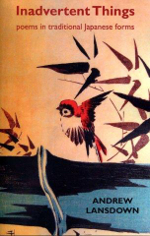
Inadvertent Things – Poems in traditional Japanese forms
by Andrew Lansdown, Walleah Press, 2013
Andrew Lansdown’s poetry has long been defined by the primacy of the image and a preoccupation with form. Inadvertent Things revisits the themes of nature, family and God through the familiar Japanese forms of tanka and haiku, and also the choka, a sort of extended tanka. The haiku is the form that features most often and always as part of a suite called a gunsaku, where the poems work independently but also cumulatively. All the terms are explained in a short introduction for the uninitiated, in which Lansdown expresses his intention to follow the spirit rather than the letter of the law.
As in Lansdown’s other collections, small details matter. Take the tanka ‘Azure’:
Surely a piece is missing from the azure robe of the Madonna in some ancient mosaic because of that fairy wren!
Lansdown’s imagery is precise and inventive. The tanka ‘Caress’ is simply one perfectly realised simile:
As one gorilla might caress another with the back of its hand – just so this excavator gently nudges the brick wall …
As in the best translations of classical haiku, seemingly unremarkable details, captured through unadorned language, can produce a satisfying whole in which every syllable counts. This is the first part of ‘Loquats’:
My littlest boy – dropping from the loquat tree after his brother.
It is not only the simple but exact choice of words that appeals but the way the syntax unfolds, withholding completeness until the final word sends the reader back to the opening line, creating a perfect circle.
Humour is employed throughout Inadvertent Things, not the laugh out loud kind but the kind to make the reader smile in recognition. This haiku from ‘Frog Cacophonies’ is worthy of the Japanese master Issa:
Oh stop, you jolly little frogs – it’s unseemly to be so happy!
Other poems play self-consciously with the idea of form to pleasing effect. ‘Crab Shell Haiku’, for example:
i. Like an empty shell a haiku offers a home to a hermit crab. ii. Like a hermit crab a haiku offers new life to an empty shell.
But for all the fine poems in the book – and most of them are good – others fall short. There are places where the writing is overly cute, as in the final haiku of ‘Pygmy Bat’ and the second part of ‘Jonquils and Daffodils’:
The pup of a pug – That’s how you look, pygmy bat, with that ugly mug! Perfectly pretty, jonquils – but also, alas, painfully pongy!
The abundance of poetic devices is cloying and the effect of the rhyme above (and in a few other places) lands somewhere between a haiku and a rhyming couplet. There are chokas in the book where rhyme is effective, but rhyme rarely works in haiku because it tends to draw attention to itself and complete or close off at the expense of the meditative quality that is the form’s chief appeal.
In other cases, the lyric is prosaic or flat. The following parts of ‘Birth Haiku’, for example, lack the surprise or the interesting juxtapositions that characterise classical Japanese haiku:
v. A steel suction cap – the doctor settles it in, adjusts the vacuum. vi . This delivery – who will deliver her from the doctor’s pulling? vii. His misshapen head – the doctor explains, ‘That’s just where the suction was’.
The inclusion of such material is unnecessary because Lansdown has always been prolific and this book – stretching to 161 pages – could easily have been shorter.
Lansdown is one of our best writers of haiku and poetic miniatures and, for those interested in Japanese forms, this attractive volume is worth purchasing. For those concerned less with such forms, other books by Lansdown, such as the award-winning Between Glances, will be a better introduction to the poet’s work.













